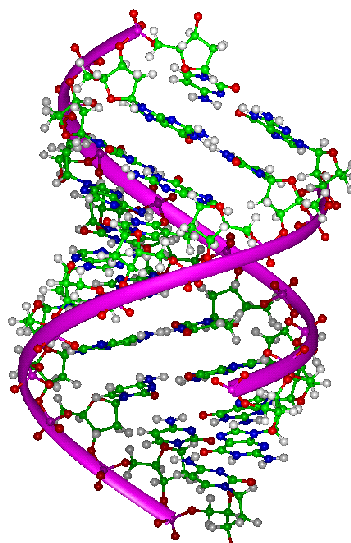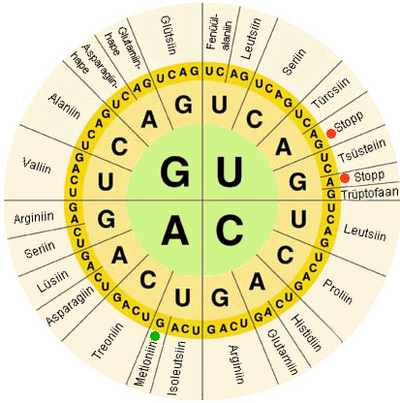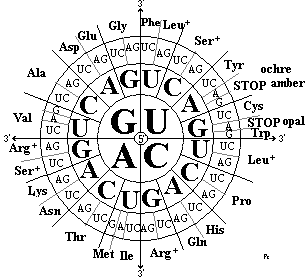Difference between revisions of "Translation Protein synthesis"
| Line 67: | Line 67: | ||
http://nl.wikipedia.org/wiki/Genetische_code | http://nl.wikipedia.org/wiki/Genetische_code | ||
| − | [[Image:kooditabel.png|400px]] | + | [[Image:kooditabel.png|400px]] [[Image:tabelll.gif|400px]] |
Latest revision as of 15:35, 28 September 2006
All body cells have a unique genetic code to create the proteins the body needs
The genetic code is store in the cell centre, where the chromosens can be found. These are made of a coat of proteins, with a dubble DNA-Helix in it.
The DNA exists of a double chain of nucleotiden. The order of the nucleotide is the basis of the genetic code.
transcription
To create a certain protein, starting from the genetic code you need
- DNA
- Messenger RNA
- Transport RNA
- Ribosomes in the cytoplasma
All starts in the cell core because the chromosones are locked in there. They can not migrate to the cytoplasma of the cell
In the centre, because of the working of the enzyme, the DNA opens up: the hydrogen-bridges between the bases are broken. the double helix is "zipped" open.
The piece of DNA that came off the bottom chain works as a possitive mold of which in the nucleus (core) a sort of neg ative copy is made in the shape of primary RNA
RNA is a Nucleic acid that is different from the DNA in a few facets
- The chain is always single
- The basis thymine is replaced by uracil
- The sugar molecule is ribosse (iso desoxyribose
On the primary RNA-line there are also some pieces of "nosens" which are called intrans. These are cut out with special enzymes (splicing). What is left is the messenger RNA
The three successive nucleotides on the M-RNA make a threesome or codon.
The codon then becomes a mold for 1 specific Amino acid.
transcription (translation of the mrna line to a proteine
the MRNA moves now with the copied code to the cytoplasma of the cel. There the codeword is delivered to the ribosomen, where the protein synthesis takes place.
In the cytoplasma there are a lot of little pieces of RNA. These are shaped as a clover-leaf . They each transport an aminozuur and that is why they are called transport RNA or tRNA. So they can offer parts of the proteine that you want to build to the ribosomen.
The middle part of the clover-leaf carries an marker to recognise, called an anticodon. With which the tRNA can attach itself to the codons of the MRNA.
Because the aminoacids end up on the right place on the ribosomen in the cell, they can bind to each other.
Every time an Amino acid is bound to a chain, the transport RNA becomes loose.
The ribosome the slides to the left and there will be a free place for a new tRNA with a matching aminoacid. And that is how the protein chain is build
Most of the time different ribosomes are reading the M-rna simultaniously. what actually imploes (means) that from 1 MRNA more identical proteins can be made.
One mistake in the DNA or the mRNA is sufficient (enough) to make the wrong protein.
Because of this the error free copying of the information in the DNA when a cell splits is of extreme importance for the organisme!
read more on http://www.bioplek.org
http://www.bioplek.org/animaties/moleculaire_genetica/transcriptie.html


